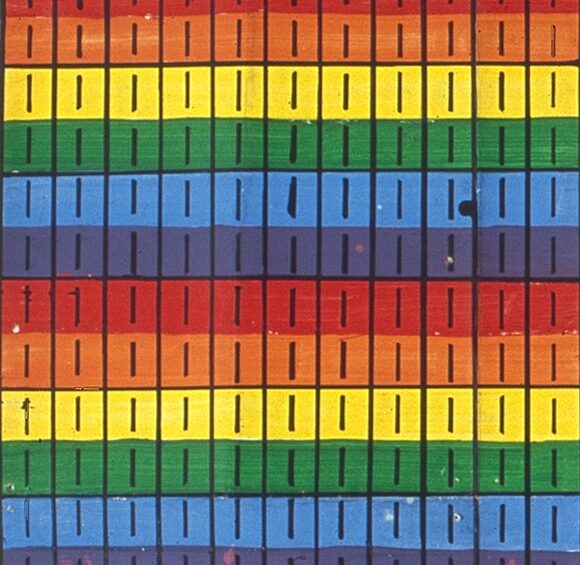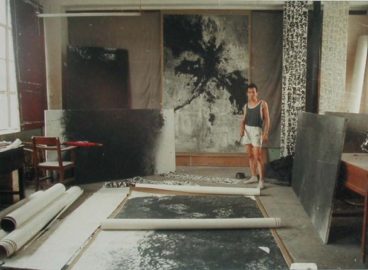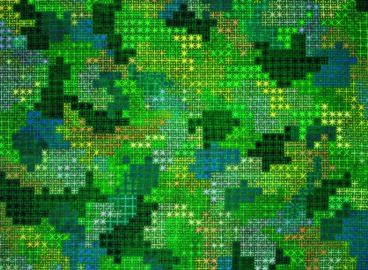The name Ding Yi is associated with the cross, a symbol the artist, designer, and educator has used since the late 1980s in his investigation of abstraction. Ding’s allover painting fields are built from the manual, systematic repetition of horizontal and vertical strokes across a flat, canvas surface.
Ding grew up during the Cultural Revolution, and the art education he received in Shanghai was largely unsystematic and can even be described as “experimental.” This unique, nonlinear “curriculum” included drawing propaganda posters, making bricks for bomb shelters, studying interior design and Chinese ink painting, and performing in public spaces. In this conversation, he talks about his trajectory and explains how he came to abstraction. His participation since the 1990s in a series of overseas exhibitions about contemporary Chinese art has solidified his conviction that experimental contemporary art from China has a long way to go. Today, although his eyesight has weakened, he still insists upon painting each stroke himself as a way to resist the commercialization of art.
Part 1: Growing Up During the Cultural Revolution
Yu-Chieh Li: Professor Ding, you studied in the art program at your middle school, where you mentioned that you were required to paint political posters. Later on, when you entered the Shanghai School of Arts and Crafts, you majored in interior design . . .
Ding Yi: Decorating design . . .
Li: Yes, decorating design. Later on you worked in a printing house and a toy factory, and you majored in Chinese ink painting. In 1988 you began the Appearance of the Crosses (Shi Shi) series, and recently you have been doing environmental art. It is interesting to see how you began by making art for practical purposes, then moved to abstract painting—or to making art for art’s sake—and now, more recently, combined art with life and the environment. Perhaps we can begin by talking about your early art education; some of our audience did not live through the Cultural Revolution and so might not be familiar with political posters. Could you describe what it was like to work on political posters in middle school? How were they made? And what was the education like at that time?
Ding: I attended middle school in the 1970s. At that time, the artistic environment was bizarre; there was barely a true educational system, though there were programs that nurtured talent in the arts and crafts. I remember some senior classmates at my school—they were talented in painting, and so when they graduated from middle school, they were assigned to factory jobs. These could be at carpet factories or jade-carving factories. Both types of factories were actually part of the country’s attempt to generate foreign income through the exportation of Chinese arts and crafts. Carved jade, woodcarving, carpets, and tapestries were all exported at the time. Within this context, all of the arts served the state and its political goals.
When we were growing up, the only art that was available to us was political in nature. This is why the Shanghai Museum of Art, which was called the Shanghai Art Exhibition Center, didn’t count as a museum of art—it held annual exhibitions centered on themes related to the national holidays. For instance, on January 1st there were exhibitions about the New Year’s celebrations; on May 1st there were exhibitions about Labor Day; on June 1st there were exhibitions about Children’s Day; on July 1st there were exhibitions about the anniversary of the Communist Party; every August there were exhibitions about the anniversary of the establishment of the military; and every October there were exhibitions about National Day. All of China’s state-run exhibition centers held these exhibitions on a regular basis. Therefore, the art we were exposed to in our younger days was whatever was presented in these exhibitions. This is why the artistic education back then had limited scope and perspective—the art world was confined and small.
I grew up on the second floor of a building across the street from a cultural center. Through my windows, I could see the cultural center plaza. What appealed to me most was the iron-sheet billboard on the plaza—now it is used for advertisements, but back then, it was used for the display of political posters. Every year professionals would repaint it. Their huge, iron-sheet displays usually had two sides. On one side, there might be political propaganda, that is, big, printed words—or maybe something Chairman Mao had said. On the other side, there would be a painting. I was fairly young then, probably in elementary school, and every year when someone came to repaint the painting, I would be so excited. I would go downstairs, cross the street to the plaza, and stand in front of the cultural center and watch them paint—sometimes for half a day. At that time, because our perspective was so limited, I thought that this was art and that they were artists—and I wanted to become like them.
Later on, when I became interested in art and had improved my artistic skills, my classmates elected me to the propaganda committee. The committee’s main task was to produce wall posters and blackboard posters. The blackboard posters had to be updated weekly; for instance, we would choose the best student journals of the week and copy entries from them onto the blackboard. These appeared on the blackboard at the back of the classroom; generally speaking, the blackboard in the front was used for teaching purposes while the blackboard in the back was for political discussion or student politics, including students’ ideas, thoughts, and so on. Since, among my peers, I was the one with talent in art, I was in charge of doing illustrations for the blackboard. At the time, the only thing that made me believe I had talent was the fact that I had learned the job really fast. The average elementary or middle school student would find a reference and then copy it, and I quickly learned to do this—that is, I memorized all the established references. Every semester there was a blackboard poster evaluation, and for many years in a row our class blackboard—my work—was voted the best, and so eventually I was recommended to the grade blackboard poster committee. Each grade had a blackboard poster, as did the school. When you walked through the main entrance to our school, you would see blackboard posters on both sides of the aisle, along with some display windows. The display windows contained things like award certificates and the works that had been chosen from each class for the school blackboard posters. I remember feeling privileged back then, because it took quite some time to decorate these blackboard posters—both the grade blackboard posters and the school blackboard posters.
At least once or twice a week we would have political broadcast class, and the whole school would listen to a political broadcast. These classes took up two class sessions or sometimes even the whole afternoon. My teacher would often assign me to blackboard poster duty during this time, and so I was exempt from attending classes about political education; instead, I would get to paint posters for the blackboard. It was good for me, because I had a legitimate excuse not to attend classes. Later on I became somewhat famous for my blackboard posters, and when the school art program began recruiting, I was recommended for it. Once I joined the art program, I took foundation courses and began to develop technical skills. The course was mainly painting. Students would take turns modeling—then we would sit around whoever was modeling and sketch; other times we would do studies of jars and other objects, practicing our still-life drawing skills. And just like that, little by little, I felt like I was finally onto something fundamental about painting.
Li: So you had sourcebooks or prototypes for the images on the blackboard posters, is that right? Where did those come from?
Ding: They were published all across the country; there were collections of what we called “newspaper masthead posters” or “compilations,” along with all kinds of images and patterns published together as books of reference. These books were filled with bizarre political symbols—that is, from the perspective of today’s young people, they would seem bizarre and inconceivable. For instance, there would be an image of the five-star emblem from the national flag in the middle, surrounded by something traditional, such as a piece of an award certificate, or there would be ocean waves or a picture of Chairman Mao wearing an octagonal hat . . . but more often than not, there were huge fists pounding down someone or something . . . symbols like that.
Li: So your memories of the Cultural Revolution are different from those of other artists, who remember spending time in the rural areas? Instead, you spent your time in school, learning and painting blackboard posters?
Ding: I was only four years old when the Cultural Revolution broke out in 1966, and so I didn’t experience much of it firsthand, but I do have memories of that time. For instance, I remember a neighbor who was a factory director; he was persecuted and then paraded down our lane. I also remember physical struggles [wudou].1Wudou are physical and/or violent struggles. During the Cultural Revolution, many people who were classified as dissidents faced struggles of all kinds. Verbal struggles included public humiliation, severe criticism, abuse, harassment, and such. Physical struggles included imprisonment, torture, and even seizure of property. Such “struggles” were encouraged and executed throughout the country. As a kid, I was especially attracted to fire trucks, and I have vivid memories of one scene in particular—it involved two groups of people in Shanghai who fought against each other in a violent struggle. One group sat on a fire truck, sounding the siren, and then they drove the vehicle into the other group. Our house overlooked the street, and so I could clearly see and hear what happened. The noise of the siren was alarming to a kid, and so I rushed to the window to see what was going on. The first physical struggle I remember seeing was when I stepped out into the street. I saw more fire trucks rushing through, one by one, and everybody on the trucks was letting out battle cries.
During the latter half of the Cultural Revolution, criminals were publicly tried and then paraded through the streets before being executed by a firing squad. There was always an announcement beforehand, including details of when the “parade” would happen; many locals would come out to watch. There were huge military trucks that carried criminals who were held down by soldiers wearing steel caps; the criminals bore signs that said “Bring [Somebody] Down.” The soldiers would announce their crimes through handheld bullhorns.
As a kid, I was sensitive to many things. For instance, we were told that we were going to war with Russia, and so every household was required to make the bricks needed to build bomb shelters. Each household would receive instructions to submit a certain number—thirty bricks, for example. My father had to make those bricks; he and all our neighbors made bricks on the cement sidewalk outside our building. Kids get really excited when they see mud, and so I played in the mud. I remember making a coffin and then a person to put inside the coffin, and then a coffin lid . . . my childhood was filled with such stories, many of which are related to art.
Li: Hearing these life experiences and visual memories . . . it seems that these formal images have never appeared in your mature work. Would you mind commenting on whether these memories have influenced your work at all?
Ding: I don’t think there is a direct correlation. Perhaps as I age, though, these memories will surface in some way. But growing up in such a highly political environment . . . you get tired of it, and consequently, you feel like you would rather not express that environment. Instead, you want to get as far away from it as possible. I think this is why I want my art to be devoid of content—because the earliest symbols in my paintings were meant to be devoid of content, as opposed to directly related to daily life.
Part 2: Performances in 1986 and 1987
Li: You did performance pieces in 1986 and 1987 that seemed to echo your memories of the Cultural Revolution. After that you ceased to perform. You have actually mentioned in some of your interviews that you were involved with a group of friends, which included Qin Yifeng . . .
Ding: Yes, and Zhang Guoliang . . .
Li: You did this performance piece in 1986 . . . I think you even did it twice, once in the Wusong estuary . . .
Ding: In the Wusong estuary, and in the newly renovated Shanghai Museum of Art.
Li: Yes. And the material you used was silk, is that right? Was that what you used?
Ding: No, it was just regular cloth.
Li: It was cloth, and you wrapped yourselves in it. I’m not sure how long the performance lasted. What was the audience’s reaction?
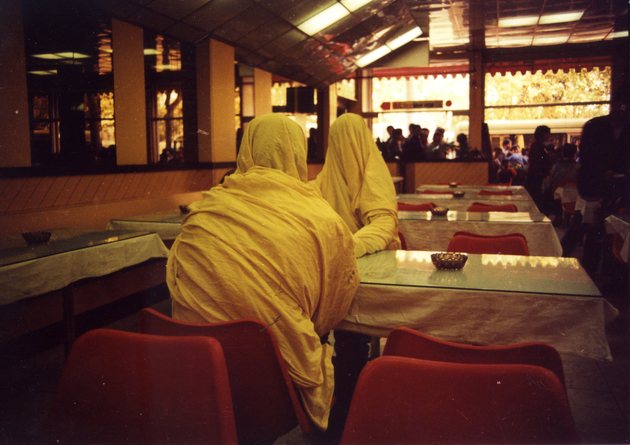
Ding: There were two performances, one in 1986 and one in 1987. The first one wasn’t meant to echo childhood memories. I had established two spots for the piece, one of them was in the Wusong estuary—along the shore, where there was an abandoned pier and some abandoned pillars; someone had recut the pillars and piled them up on the shore to serve as a flood bank. In fact, now that place has been turned into a forest park. But back then, it was the wilderness and filled with trees, and it was a secret spot we often visited for fun. Because it was far away and in the middle of nowhere, it would take us hours to get there by bike, and the whole journey would feel like an expedition, with the destination being a special, private place you went with your friends. At that time, when we set up the spot, it was on the one hand a communication between nature, the ocean, and the forest behind—and on the other, a very natural and realistic environment.
The other spot was in Shanghai. The first exhibition at the art museum in Shanghai was of work by Ren Bonian, Xu Gu, and Wu Chaoshui, three of the main artists from the school known as the “Flowers of Shanghai.” We did our performance right under the exhibition poster. We also did it in what was the trendiest place back then—the “People’s Fast Food Restaurant,”2The piece Cloth Sculpture on the Street (1986) was performed by Qin Yifeng, Zhang Guoliang, and Ding Yi. They wrapped themselves in cloth and showed up in public, without performing a specific, choreographed scenario. which had opened beside the Dafeng movie theater. Fast food restaurants were very popular in 1986; they were high-end places, and so we did our piece there, too. We also did it in some places with billboards, such as the Hongqiao area, train stations, and so on. Back then, to the general public, performance art was an all-too weird phenomenon, because it was unfamiliar—it was never covered in the newspapers. So when you did a performance in in the Shanghai metropolitan area, it would generate a lot of discussion. Back then, when we were performing, we would hear people saying, “What does this mean?” “Are they making a movie? Or are aliens coming?” Anyway, there was a lot of exclamation, confusion, and doubt expressed. I wouldn’t say that any of this was directly related to my childhood memories.
Yet, in 1987, I did another piece, this one at school; at the time, I was majoring in Chinese ink painting at Shanghai University. This piece was somewhat related to the Cultural Revolution—since it used red paper and some slogan-like texts. But, in fact, those “slogans” were more common catchphrases of the time as opposed to language used in the Cultural Revolution—but the scene created did resemble the Cultural Revolution period a lot. For one thing, it included slogans and, for another, it was wrapped in red paper, and so it did seem to echo aspects of the Cultural Revolution. However, our original intention was to dispel meaning, and so we chose everyday statements—for example, “Have you eaten yet?” or “I need to finish my homework.” These were colloquial, regular phrases from everyday life, but we used them as slogans. All in all, the two pieces had distinct intentions—and they addressed different social contexts and systems.
Li: Yes. But in both performances, you wrapped yourselves in cloth. So it seemed more like a display or pose than a dramatic performance. Did you encounter police interference the first time you performed in a public venue?
Ding: The police were watching us . . . but they didn’t understand the concept of performance art. In fact, they were clueless; they assumed we were shooting a commercial for some government institution. This was because back then, even for a commercial shoot, the police felt obligated to maintain order, and they rarely saw anything on the streets like what we were doing. The truth is we didn’t encounter any problems with the police. Both of these performance pieces were covered in Fine Arts in China and the Jiangsu Art Monthly. There was a newspaper called Shanghai Culture and Art Newspaper, and it featured them on its front page. I really didn’t see it coming—how this performance would get so much media attention. Some newspapers even did significant pieces on it. I remember there was also the Youth Daily of Shanghai and the Young Generation, which was a magazine targeting a younger audience, such as college students. I remember a more interesting case with the official newspaper of Shanghai, the Wen Wei Po. A young journalist from Wen Wei Po got our phone number from somewhere—I had no idea from where—and called us directly, hoping to get an interview. We didn’t have an independent studio yet, nor did we have another venue or money to go to a place like the People’s Fast Food Restaurant, and so we ended up doing the interview in a park. We sat on the grass and chatted for a whole afternoon; it was quite amazing.
Part 3: The ’85 New Wave and the Painting about Crosses
Li: So the situation back then was that you organized exhibitions with some friends, along with doing performance pieces. What sort of role do you think you played in the ’85 New Wave Movement?
Ding: The ’85 New Wave Movement happened at a pivotal time for art in all parts of China. Although there were art activities across the country, the number of people who participated in the ’85 New Wave wasn’t large—and though some of the activities could be deemed contemporary art, many of them didn’t look so much like contemporary art. Sometimes certain work would be included in the art system merely because it stood out a little. We know that the political language of the seventies started to move toward liberalization in the eighties. The ’85 New Wave artists were not at all in the majority in terms of the art scene. I studied at the Shanghai School of Arts and Crafts from 1980 to 1983, and then I went on to major in Chinese ink painting in the art program of Shanghai University from 1986 to 1990. I was a student during this time, and due to my interest in contemporary art, my own artwork was closely related to what was going on with it. I also sporadically took part in some exhibitions in 1985 and 1986; back then, there weren’t many exhibitions held in China. What I mean to say is . . . there were no boundaries back then. That is, being a member of the ’85 New Wave . . . there was no distinction with regard to age, qualifications, or experience, because the art groups were loosely bound, and the teachers and students were essentially starting from the same place.
This is why our artwork—including the performances in 1986 and other pieces—ended up being covered in the best journals of so-called contemporary art. This is also why when we interacted with certain older artists, such as Yu Youhan, who was already a teacher when I was a student at Shanghai School of Arts and Crafts, we were able to do so outside of school. He did not think of himself as a teacher and I did not think of myself as a student; we were friends who belonged to the same small group of liberal artists and so we would get together. We had an ordinary friendship. I could stop by his place whenever I wished, and he would come over whenever he felt like it; we would see exhibitions together, or when I was free, I would stop by his dorm and chat all night. This is what it was like back then. I was not just a participant in the ’85 New Wave, I was also its beneficiary. Through marketing in art media, a lot of information was gathered together and published, for instance in Meishu magazine, and especially Fine Arts in China magazine, Jiangsu Pictorial, and a magazine in Wuhan called Art Trends. There were also some journals from Shanghai and academic publications, such as the Foreign Art Material of China Academy of Art.3China Academy of Art was called Zhejiang Academy of Fine Arts back then I had subscribed to it in 1979, even though its content wasn’t very systematic. It would at one point introduce Russia, and at another introduce Impressionism; nevertheless, it satisfied the needs of many who yearned to see more. These information platforms provided constant—albeit chaotic—artistic information.
Li: What I find interesting is . . . we just talked about the ’85 New Wave, and then how, soon after you did performance pieces in 1987, you came up with the first work in the Abstraction of the Cross (Shi shi) series, which you began in 1988. You have mentioned repeatedly that although the Chinese character shi [which is exactly the form of a cross, used repeatedly in the painting] is a loaded symbol, it is, to you, meaningless. For instance, when block printing, the symbol of the cross is used as an alignment mark. However, I find it interesting that many artists from the ’85 New Wave generation mention “emptying the content.” Many have said that after being passionately involved in the ’85 New Wave, they decided to take a step back. I wonder what your inner journey was like when you developed the artwork for the Abstraction of the Cross (Shi shi).
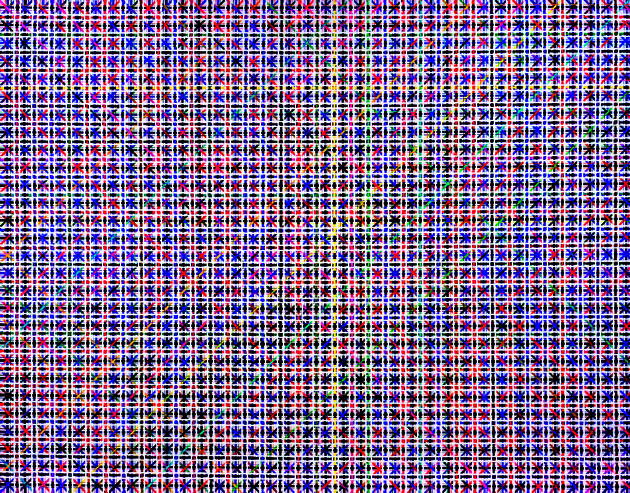
Ding: I guess I could say that the development of the Abstraction of the Cross was related to the ’85 New Wave. When I look back at the ’85 New Wave, I can see that it actually had great impact; it was a political movement with incidents that sprung simultaneously, without any plan beforehand and without a specific leader. There were small art groups, but never a powerful leader. The leaders of the government used these platforms—such as Fine Arts in China —for announcements. After the ’85 New Wave, I believe every artist was reflecting on what to do next, on how to proceed, and on how to evaluate the art-related activities of the time. I, too, was trying to figure out how to deal with such an overheated, disorderly situation. Why was it called the “New Wave”? Because it felt like a continuation of the later part of the Cultural Revolution; it resembled a movement or a trend.
My overall opinion of the ’85 New Wave is that it stemmed, in fact, from one of two inclinations. One of them is Expressionism in art. We know that many people were politically suppressed and so adopted an Expressionistic style as a kind of outlet; some of this work corresponded directly with Western styles, such as German Expressionism or Neo-Expressionism. The other is Surrealism. I believe there are several reasons why Surrealism was compatible with the political atmosphere back then. One reason is the fact that Freud’s theories had become available through translated works, which helped advance Surrealism. In addition, Surrealism was perfect as an extension of academic art. Back then in China, many people were trained in the academic system, and so they had great drawing skills and could make realistic paintings; more often than not, it only takes a change of theme or content to turn a realistic work into a Surrealistic one. This is why many artists could easily make the transition. Furthermore, I think that Surrealism offers a broad path in that it can be extremely abstract and filled with imagination. Examples include the Yunnan Painting School of the time, which I believe is actually Surrealistic—the way it presented the exotic was best expressed through Surrealism. I believe that these two tendencies are the most important things about the ’85 New Wave. In reflecting on them, I felt like I should become a rational artist, one who distances his artwork from such a foundation or background. I also started to consider more individual concepts of creation. For instance, I claimed at the time that I wanted to make my paintings as un-painting-like as I could. And so I incorporated design techniques. At first the results were difficult for the public to accept, because the work seemed less like painting and more like wallpaper or other non-art images. I wanted to use transformations such as these to open up art’s possibilities and to broaden artistic expression; these were my principal concerns back then.
Li: I find it interesting that you say that you wanted to make art that wasn’t art-like. You weren’t thinking of abstract painting as falling into this category, though. Is that correct?
Ding: Yes. In fact, after the performance piece in 1987, I did wonder whether I should continue doing performance. Meanwhile, I was painting; and I wondered if I kept on painting, how I was going to paint. At the time, I had started experimenting with abstraction, but I hadn’t developed a clear style. Thus, I needed to decide which path I was going to take. In fact, the making of Abstraction of the Cross in 1988 was the result of careful consideration. I was determined, assured that that was what I wanted, and so the first and second pieces in that series were almost of a declarative tone—an announcement to the world that “I want it to be this way.” For instance, the first piece was The Three Primary Colors —red, yellow, and blue—and the second piece was The Seven-Color Spectrum. Whether structure-wise, color-wise, or from the perspective of painting method, this work was a declaration; it declared, “I want to take this path,” and it started me down it.
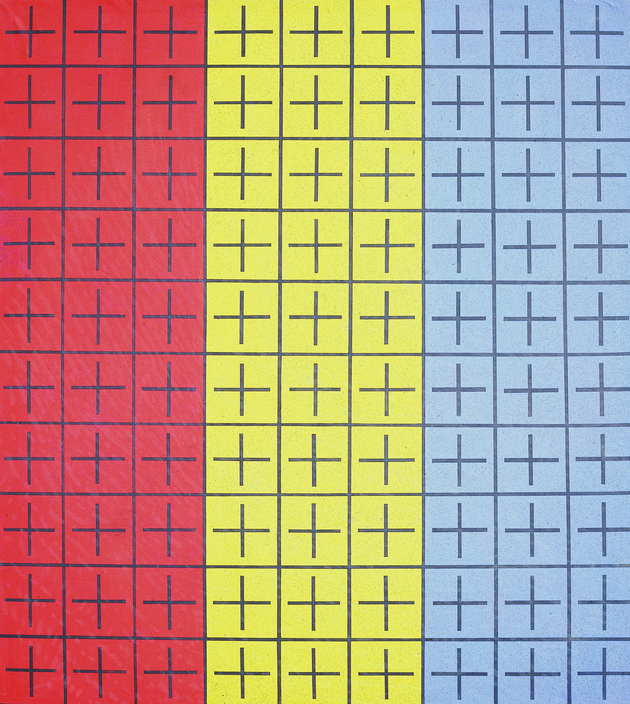
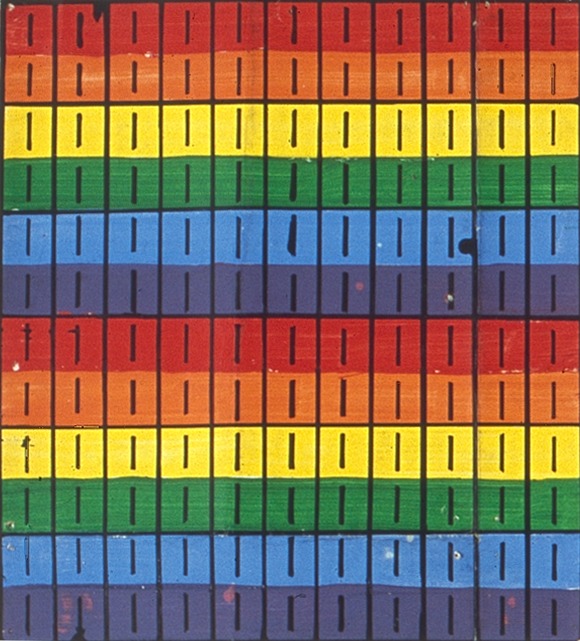
Li: Yes. But several of the works from that time seem to be flatter in terms of technique, and you used rulers to paint them. Interestingly, it seems that your work from the early nineties on possesses obvious brushstrokes, and in some of the paintings, the margins are blurred, almost as if the line between the world inside and outside the painting isn’t clear. But take the black-and-white painting behind you as an example . . . in it, we can see that you clearly defined its boundaries. I wonder what role “margins” or “boundaries” play in your work?
Ding: I handled margins differently for different materials and during different phases. Take materials like chalks and charcoal, for example . . . I usually leave an unpainted area on the edge because these materials need to be fixed with glue when finished, and the glue is applied over and over again. As a result, the powder bursts, blurring the margins naturally, giving them a little character. These were more technical considerations. Or, in 1997 and 1998, when I used cloth, I also left some unpainted areas on the edges. These margins were meant to provide contrast between the original part and the later, covered part, and so I wanted to leave them. Such emphasis was needed at first, but if, after two or three years, it was not, I would remove them. Meanwhile, the base color of the Abstraction of the Cross works had changed; the original background was the color of the cloth, but in 1998 I had to repaint the color of the cloth completely. All in all, the way I handled margins depended on the materials I was using and the ideas I wanted to convey.
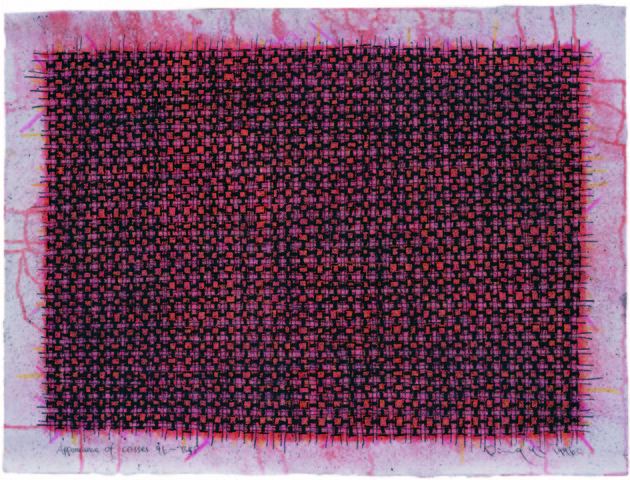
Li: I see, too, that crosses appear in your works in various patterns, and also, depending on your materials, the brushstrokes are visible. The style of this more recent work is different from the colder abstraction of your earlier works. People would quickly identify the Abstraction of the Cross series as “Ding Yi’s work.” In recent years, crosses have appeared in your sculptures as well, making the symbol almost your signature. The series has indeed been through a lot of changes, and now it has a personality all its own; I wonder what you think of this.

Ding: Well, I have never really given any thought to the idea that the series has its own personality. When I work three-dimensionally, I often feel torn because sculpture necessitates a different working method. Should I continue with the cross, or should I abandon it? Sculpture can be two things at once—that is, it can be a functional object and it can also be art, which is why I love it. For instance, when designing a bridge, I see the design itself as art, and the bridge as art. In the big studio next door to this one, there is a model of a bookshelf, which I am using as a pillar; so now the pillar can hold books as well as be a work of art, and it might even subtly express the concept of piling up precariously. Therefore, this object can be a lot of things at the same time. This kind of sculpture is most compelling to me.
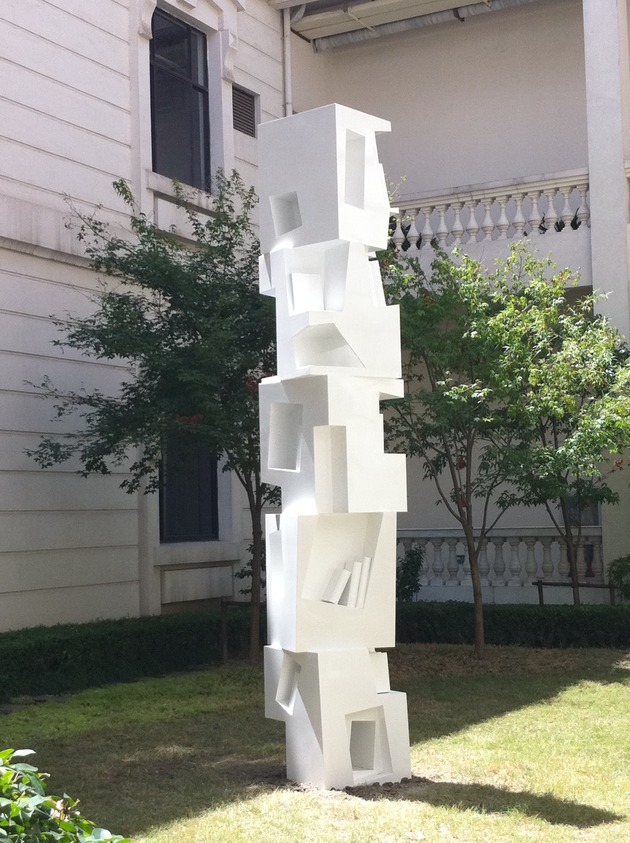
Li: We were just talking about creating a painting that is a not painting as well as rational paintings. What intrigues me more is that today, many artists, since about 2000, have hired assistants to help them with their work, and yet you still insist on painting all your works by hand and by yourself. Why is that? If it is a purely rational way of working, is it possible to accomplish it without being personally involved?
Ding: I have two reasons for working independently. The first is that I enjoy the process. I have enjoyed painting ever since I was a kid, and so I think of making my work as an experience that is close to living my life. An artist is not an architect, or someone who comes up with an idea and then has a construction company realize it for him. Art creation, especially painting, is connected to your emotions. I believe that when it comes to painting, the ultimate pursuit is the communication within and how you try to make work that will, in turn, make your audience feel something. If an artist doesn’t devote himself to expressing his ideas through his artwork, or if he proceeds without emotion, then it would be very hard for him to communicate with his audience emotionally. The other reason is that I believe that art today is much too commercial and too focused on short-lived impacts. I think that given this situation, as artists, we should perhaps more carefully consider which artistic paths we take. This is why, though everyone else uses assistants, I choose not to. I believe that that there are some things that one must do oneself.
Li: I noticed that you use a lot of colors. Sometimes clean colors and murky colors might appear in the same painting. Do different colors rank differently to you? Are the colors symbolic of anything?
Ding: Hardly ever. There are no symbolic meanings in my choices. In fact, I like colors and think I’m good at using them. But for many years—twenty years or so—I have rarely relied on a palette. In fact, I don’t mix my colors; I apply them directly. Be they tube colors or canned colors, I just apply them directly. I don’t know; I just never thought of using a palette; I’ve abandoned the one I had from my school days. In any case, I think that color is just one means through which artists express themselves, and so as long as you believe that you have expressed yourself, it is enough. This is my approach. Now, the colors from different phases were related to the ideas, themes, and concepts that I wanted to express. For instance, this creation with fluorescent colors was, in fact, related to the denseness of Shanghai City. Yet sometimes colors can create problems. For instance, the phase when I used fluorescent colors was the twelve years I was closest to society and reality; I went from being full of ideals, joy, and hopes for this city to being a little pessimistic about it, and so then I stopped using them. Another reason may be the degeneration of my eyesight; because the colors were so stimulating and I was working at such close range to them, they may have affected my sight. I sometimes needed mediation or a pause, and I would use the pause to prepare myself for the next transformation or to reflect on my next theme. I often resort to a method of my own—I go back to black and white and adjust my pace. Nevertheless, I cannot hold back my love of color. Within two years of adjusting, I went back to colors—never to fluorescent colors, though, because it was impossible to work with them again, but to others.
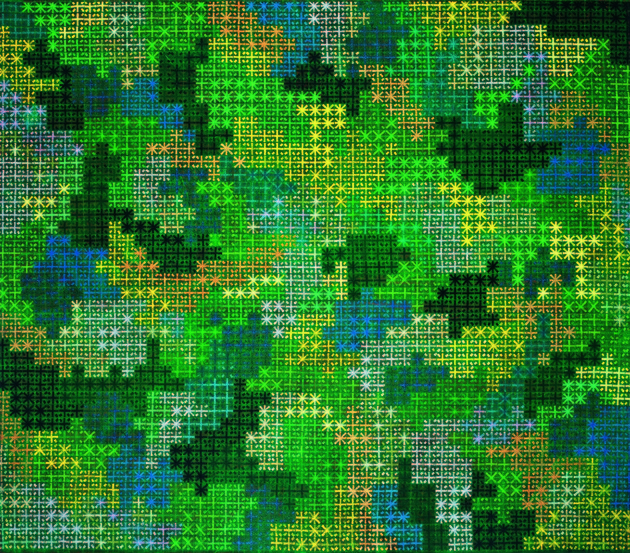
Part 4: Exhibitions Overseas in 1993
Li: I would like to talk about how in the eighties and nineties, there were changes in the way people made art in China, or more, changes in the reception overseas of art from China. I know that you took part in the 1989 China Avant-Garde exhibition in Beijing. You also took part in a series of overseas exhibitions in 1993, including the Venice Biennale, the Asia Pacific Triennial of Contemporary Art in Brisbane, China Avant-Garde in Berlin, and China’s New Art, Post-1989 in Hong Kong. Would you mind sharing your experience of going abroad for the first time, and how it has affected the way you work and/or what you think about art?
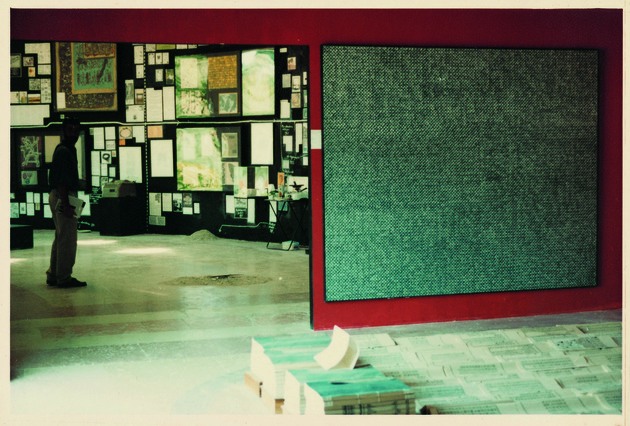
Ding: After China Avant-Garde, many artistic activities, artistic ideas, communications, and platforms were restrained for political reasons. But if you look at the situation from a historical perspective, this situation was beneficial for artists as individuals. This is because, without access to the outside world’s activities, many artists returned to their own studios, calmly and quietly sat down, and reflected on their artistic paths. So from the perspective of the history of Chinese contemporary art, between the years 1989 and 1993, many artists matured. I also matured during this time; I had time to focus on my own work, which led to the overseas exhibitions. I remember that among those overseas exhibitions . . . Hans van Dijk was the first to come looking for Chinese artists, for the China Avant-Garde exhibition at the Haus der Kulturen der Weltin Berlin. He was among the first to visit Chinese artists in China in 1992, and he selected fourteen of us to take part in his exhibition in Berlin, which later toured. Not much later, Johnson Chang came looking for artists and he ended up doing the China’s New Art, Post-1989 exhibition. Meanwhile, Brisbane came looking for artists for the first-ever Asia Pacific Triennial of Contemporary Art; Venice Biennale was last. These exhibitions were the first round of events in the international advancement of China’s contemporary art. I went to the Venice Biennale, and since I had never had a chance to see such a big international exhibition on contemporary art, I was very excited. I got to see a lot of things, and it was also my first trip abroad. I feel like this trip was a miracle, because I got to catch up on all of Western art, in the most basic way. I just walked into any building that said “museum” on it—whether it was classic or contemporary art, I saw it all. I think I visited about twenty cities in Italy; I visited museums in all those cities and saw art from ancient Rome and the Renaissance, as well as contemporary art. It was an extraordinary experience.
Li: When those four groups of curators came looking for artists, did you feel they had different approaches toward contemporary art in China?
Ding: I didn’t at first. But about six months after each of the exhibitions took place, I received copies of the media coverage. Two packages were more thorough—the ones from the Haus der Kulturen der Welt in Berlin and the China’s New Art, Post-1989 exhibition. The curators of these shows sent me a lot of press, because the media reported on their shows most frequently. When I first received those clips, I was really excited. There were copies of articles from of all kinds of newspapers reporting on contemporary art. Soon enough I realized that in that big pile of copies, my name came up once in a while, but images of my works rarely appeared. I understood that, from a professional perspective or from the art museum curator’s perspective, abstraction was necessary to enrich the diversity of the exhibitions. There were multiple schools of Chinese contemporary art back then, with very different approaches. However, the media seemed to want to present a more homogenous picture of China. From their perspective, it didn’t make sense to talk about China through abstract art, and so they generally left it out. They just didn’t report on it at all—nor would they place an image of abstract art on their more important pages. All the images were about Mao Zedong, of baldheads, or of other images of the rogues, because these were the images that the audience could relate to and recognize as having come from China. This also made me realize that my art is, in fact, a marathon; it is not a single symbol or one spot on the timeline or a leading force; it is indeed a type of art that requires effort over a long period of time.
Ding Yi’s Studio, Shanghai, November 25, 2014
Translation by Lina Dann. Edited by Yu-Chieh Li. The video interview in Chinese is available here.
- 1Wudou are physical and/or violent struggles. During the Cultural Revolution, many people who were classified as dissidents faced struggles of all kinds. Verbal struggles included public humiliation, severe criticism, abuse, harassment, and such. Physical struggles included imprisonment, torture, and even seizure of property. Such “struggles” were encouraged and executed throughout the country.
- 2The piece Cloth Sculpture on the Street (1986) was performed by Qin Yifeng, Zhang Guoliang, and Ding Yi. They wrapped themselves in cloth and showed up in public, without performing a specific, choreographed scenario.
- 3China Academy of Art was called Zhejiang Academy of Fine Arts back then
